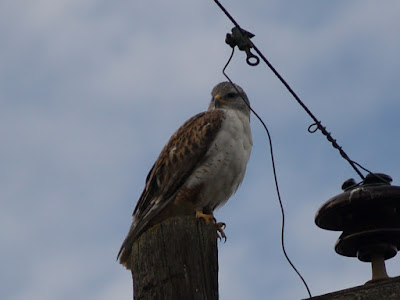This past spring I received a surprise e-mail from Jeff Manker, my former college roommate and the person responsible for lighting the birding fire for me. It seems that while searching for information and resources for an Ornithology course he was to begin teaching, he came across this blog. After exchanging a few e-mails we were able to arrange a day of birding together in the area around Corralitos. It was great fun and I'm hoping that it might be possible to meet over the Christmas holidays at one of the Central Valley refuges for another day out.
When I met with Jeff he was preparing to teach what he believes to be the only ornithology course currently be taught in a public high school in California. My hat is off to him and the staff at Gilroy High School who appear to see the value in fighting for and implementing an innovative approach to the teaching of biology and field science techniques in a high school setting. I am anxious to learn more about how this experiment is working out.
Another Barbershop-birding Rendezvous
After so many years without a get-together we finally managed to make one happen! Paul and Irene had just purchased a vintage trailer that they had to haul from Portland back to Tucson, Michael had a few days off, and I was on summer vacation. Since Humboldt County is on the way home from Portland, Michael already lives there, and I rarely miss a chance to go there when I can, it was the perfect location (not to mention that it always has great birds and is where we all originally met each other). So for a few days in June there was laughter and merriment amidst the cries of birds on the shores of Humboldt Bay. Patrick was my road companion on this trip and we went north to Redding first and then west to pick up Paul in Willow Creek. The Trinity River canyon and drive along highway 299 all the way to the coast remains one of the most scenic drives you can experience. We stopped along the river several times before we got to Willow Creek just to take it all in. When we arrived in Willow Creek we had a chance to spend some time with Irene and Katherine and what fun it was after so long. Paul then piled in the truck and we headed for the coast and a meeting with Michael. After dinner on the square in Arcata it was out to the Marsh Project for some field work. The Marsh Project was relatively new when we were all undergrads and has changed significantly since that time. Lots more vegetation and more marsh as well. It is a world-class spot for birds and remains the standard in innovative nature-based wastewater treatment technology. We stayed at Michael's in Eureka that night and wore out the vocal chords trying to remember some of the old songs. The next morning it was up to Trinidad Head to see what the ocean might bring us, perhaps the best show was put on by at least two and possibly three Peregrine Falcons. After hiking around the head we headed inland for the Mad River Fish Hatchery and the woodlands that surround it. Lots of good birds in here including a Yellow-breasted Chat that we heard but did not see. From here it was back to the Marsh for a few more hours then Michael had to leave us to go to work and we headed south for Humboldt Redwoods State Park to camp and explore. The highlight here for me was taking Paul to the Rockefeller Grove which contains the largest trees in the park and is a spot Paul had not been to before. Imagine that, a distinguished HSU forestry grad and now Professor at the University of Arizona and he somehow missed the biggest Humboldt County has to offer. Our best bird here was a singing Western Tanager along Bull Creek Road. After this walk amongst the giants we climbed back into the truck and headed south to Ukiah where Paul was to meet up and stay with an old college roommate before catching the shuttle to SFO and the flight home. After our farewells and promises to do it again next year Patrick and I took our leave and rolled just a few more hours south and home to Napa.











